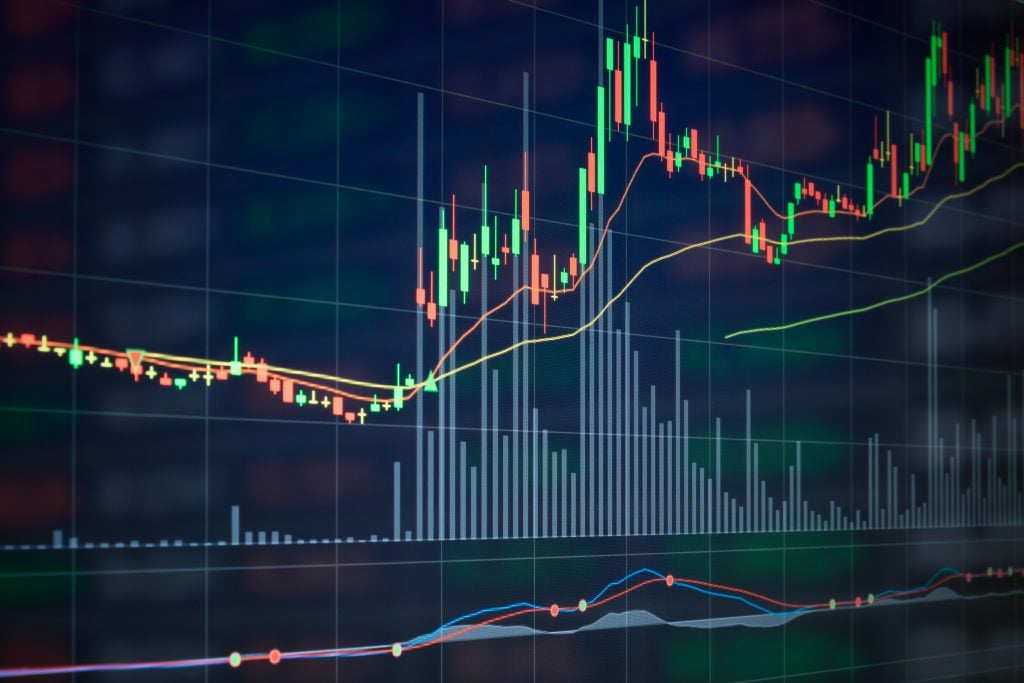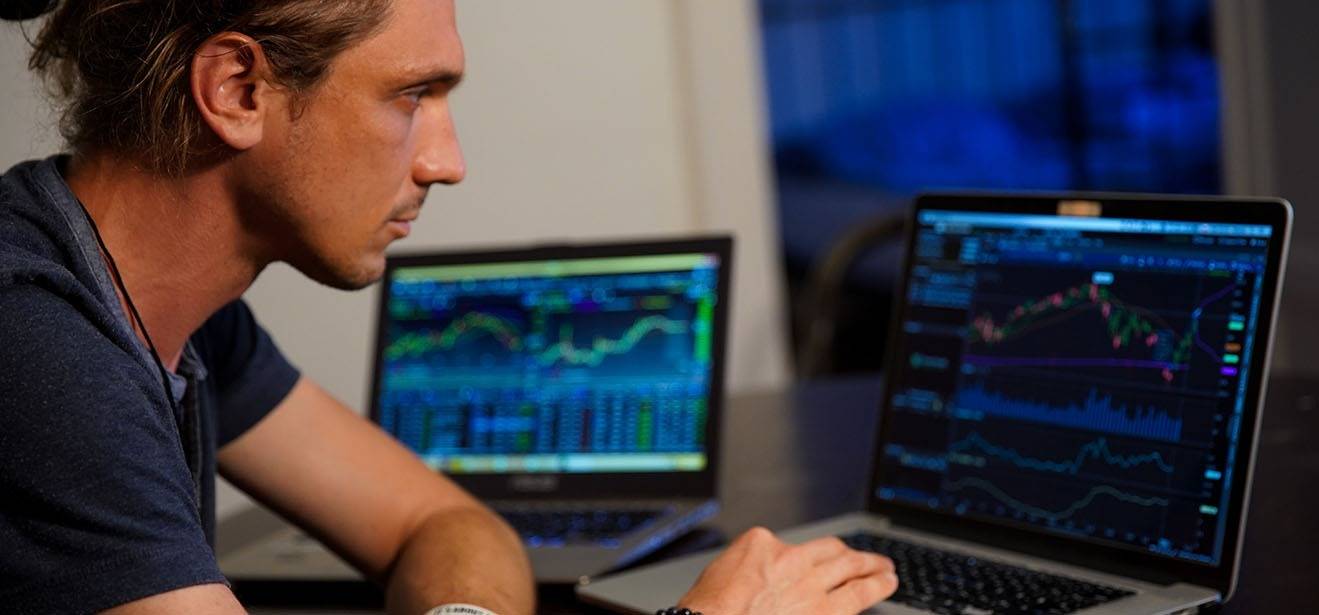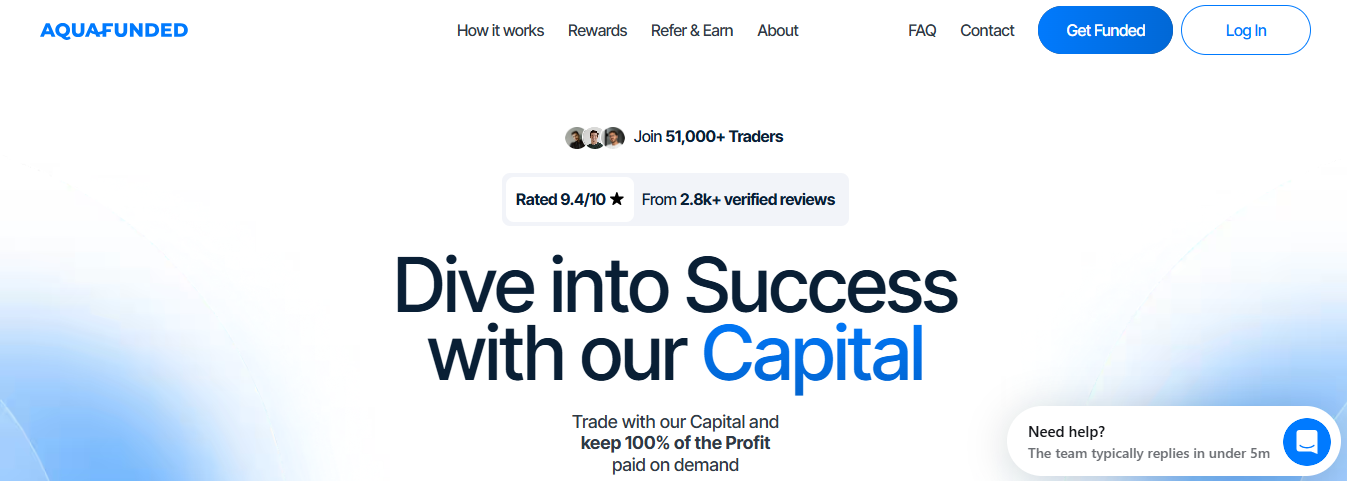How to Calculate Stock Volatility Easily
Learn how to stock volatility with simple steps. A quick guide to understanding market movement and risk, no jargon, just clarity.

When you watch Day Trading Indices, sudden price swings can wipe out a position in minutes and leave you guessing which trades are risky. Which measure tells you how wild a stock will move: standard deviation, ATR, historical volatility, or implied volatility?
This guide lays out how to calculate volatility from daily and log returns, use rolling windows and volatility indicators such as historical volatility, realized volatility, beta, ATR, and implied volatility, and turn those numbers into practical rules so you can size trades, set stops, and work toward pro trading with a funded account.
AquaFunded's Funded Trading Program can help you turn those rules into real capital by providing the backing and structure you need to trade with a funded account. It provides clear targets and real capital, allowing you to focus on execution and grow into a professional trader.
Summary
- Volatility measures the dispersion of returns and signals how jagged a trade will feel, with the VIX at 20.5 in early 2025. The S&P 500 is exhibiting a 15% increase in year-over-year volatility, suggesting a materially higher baseline for option-implied uncertainty.
- Distinguishing between historical volatility and implied volatility is essential because historical sigma is computed using past returns. In contrast, implied vol comes from option prices, and reference points such as a 20% standard deviation or a 25% annualized volatility help you judge whether your computed numbers are reasonable.
- Scale exposure to realized volatility using rolling windows, for example, 20 to 60-day log-return windows, and treat the rule that if 21-day realized volatility doubles your notional exposure, it should fall roughly in inverse proportion as a mechanical sizing guard.
- Higher volatility increases active trading opportunities and potential returns, with research noting up to a 20% higher return on investment for active traders and about a 15% increase in trading volume for highly volatile names.
- Manage intraday entries and stops by volatility, not fixed percentages, for example, using 1.5 to 2.5 times the 14-period ATR for stops, requiring a breakout plus a volume spike relative to the last 20 bars, and preferring same-session retests to reduce false-breakout risk.
- Compute volatility correctly to avoid common mistakes: convert prices to returns, use the sample variance with the N minus 1 denominator, then take the square root for sigma, and scale by the square root of time per v = sigma times sqrt(T).
- This is where AquaFunded's Funded Trading Program comes in, offering funded accounts and preset risk envelopes that allow traders to validate volatility-adjusted sizing and stop rules at real size without risking personal capital.
What is Stock Volatility

Volatility refers to the speed and magnitude of a stock’s price fluctuations over time, serving as a measurable indicator of the uncertainty surrounding future prices. Practically, it captures the dispersion of returns around the average and tells you how jagged or smooth a trade’s ride will feel.
What drives those swings?
1. Political and macroeconomic shocks
Governments, central banks, and headline events alter expectations about future profits and risk, and markets respond quickly. Policy choices, election results, central bank rate moves, or surprise trade decisions shift risk premia, and missed economic prints such as jobs, inflation, or GDP will magnify reactions. The result is that policy or data surprises turn steady trends into violent intraday moves, as price calibrations must be rewritten in real-time.
2. Industry and sector-specific shocks
Not every volatility event is broad market news. When an energy hurricane or a supply-chain outage hits a single sector, that sector’s cost structure and revenue outlook change overnight. Regulation or a sudden commodity-price move favors some firms. It punishes others by concentrating buying or selling in a small group of stocks, creating outsized swings within that sector, while the rest of the market appears calmer.
3. Company-level developments
Individual firms have their own volatility drivers: earnings beats or misses, product launches, recalls, or governance scandals. Market response is binary and fast when a company’s future cash flows are re-estimated. That makes single-stock volatility often far larger than index volatility, and it explains why a company can experience a triple or halving in a few sessions while the broader index barely moves.
How traders read volatility, practically
Historical volatility is calculated from past returns, typically using daily returns and the standard deviation formula, and then annualized to facilitate comparison among assets. Implied volatility is derived from option prices and reflects the market’s forward-looking estimate of the potential swing in prices. Knowing both helps you distinguish realized past turbulence from expected future turmoil, which is crucial for position sizing and stop placement.
When market conditions change
The baseline level of market nervousness matters. According to ETF Trends, the VIX, often called the "fear index", measured 20.5 points in early 2025, signaling a higher-than-average baseline for option-implied uncertainty. The same source also reported that the S&P 500 experienced a 15% increase in volatility compared to the previous year, which shows index-level swings widened materially year over year.
A pattern that erodes trust and amplifies moves
This challenge is evident in high-profile names and meme-velocity stocks. When large option flows or concentrated bets dominate price action, traders become skeptical that fundamentals explain every move, and that skepticism itself becomes a fuel for volatility. The emotional pattern matters because when investors perceive a stock as “engineered” rather than “earned,” many switch from measured positioning to reactionary trades, increasing turnover and making corrections sharper and faster.
Status quo disruption: how traders usually manage it, and a better path
Most traders steer risk with spreadsheets, gut judgment, and a handful of volatility metrics because it is familiar and requires little setup. That works at a small scale, but as positions and leverage grow, it fragments: signals lag, risk concentrations hide, and regulatory reactions, such as short sale restrictions, can feel ineffective and increase slippage. Platforms like AquaFunded centralize realized and implied volatility signals, provide scenario stress tests, and automate position sizing, helping teams compress decision time and reduce blind spots while preserving auditability.
A short analogy to keep this tangible
Think of volatility like ocean chop: you can handle a steady swell with a small boat, but when the chop becomes random and crosswise, you need different skills and instruments to stay upright.
But the real question that changes how you trade volatility is coming next, and it is not what you expect.
Related Reading
- What Is Considered a High VIX
- What Is a Trading Session
- What Is Support and Resistance in Trading
- What Is a Stock Market Index
- How to Trade S&P 500 Futures
- How Is the Dow Jones Calculated
- Trading the DAX
- CFD Indices
- Asset Class Correlation
Benefits of Stock Volatility

Volatility pays you in five concrete ways: it sharpens how you size and accept risk, it directly moves derivative prices, it creates tactical options for portfolio construction, it signals investor psychology, and it increases active trading opportunities. Below, I break each benefit into practical takeaways you can apply to position sizing, hedging, and trade selection.
1. Clarifies risk and forces discipline
When volatility rises, both your math and temperament are tested. Use annualized standard deviation from a rolling window of daily returns to see how jagged a position will be, then align allocation to that number rather than a gut feeling. This makes stop placement, position size, and margin planning mechanical: if your 21-day realized volatility doubles, your notional exposure should fall in roughly inverse proportion, or you will blow past your risk tolerance. This is why traders who react emotionally to a spike often regret selling into the low that follows. The pattern appears consistently across new entrants and active traders, costing them opportunities and conviction.
2. Controls options pricing and hedging cost
Options are priced based on forward-looking uncertainty, so expected volatility is the primary input that drives premiums. Small changes in implied volatility can swing an option’s price more than the same-sized move in the underlying, because vega multiplies volatility shifts into dollar terms. For anyone trading derivatives, this means managing exposure in two dimensions: direction and volatility. Hedging then becomes a volatility management job as much as a delta management job, and models that update implied volatility in real time let you size hedges and monitor vega bleed with clarity.
3. Enables volatility-targeted allocation
If you want consistent returns with controlled drawdowns, scale exposure to realized volatility rather than fixed notional amounts. A simple rule is to compute annualized realized volatility from 20 to 60-day rolling windows using log returns, then scale position size inversely to that figure. That turns volatility clustering from a problem into an opportunity: exposure rises when realized volatility falls and contracts when swings widen, preserving the risk budget and stabilizing drawdowns without compromising the upside. This is a common technique in volatility targeting and risk parity strategies, and it is far more effective than arbitrarily cutting exposure after a painful loss.
Most traders manage risk by instinct, spreadsheets, or ad hoc rules because these methods feel familiar and can be deployed quickly, and that familiarity is not necessarily wrong. However, as you seek to capitalize on larger swings, that approach conceals two costs: missed opportunities when capital is parked on the sidelines, and impaired sizing decisions driven by fear rather than rules. Platforms like a funded trading program provide a practical bridge, offering instant, scalable capital with predetermined risk parameters and clear profit splits, so traders can exploit volatility without risking personal capital or converting emotional reactions into self-defeating position cuts.
4. Reveals market sentiment in real time
Volume spikes, option skew shifts, and expanding implied volatility are crisp signals that investor psychology is changing. Watch how dispersion and cross-asset correlations move at the start of a regime shift, and you get advance notice of whether flows will concentrate into a handful of names or diffuse across the market. Reading those signals lets you tilt toward trend following when consensus fractures or favor mean reversion when panic creates oversold setups. Behaving on these signals rather than on headlines reduces the regret many traders feel when they sell too early and miss the rebound.
5. Creates more and more profitable trading opportunities
Higher volatility does more than make life noisier; it magnifies trading edges and increases market participation. Active strategies that exploit momentum, mean reversion, or option mispricings tend to find more frequent and larger setups in expanded swings. That dynamic shows up in market outcomes, as reported by Yahoo Finance. Increased volatility can lead to a 20% higher return on investment for active traders. It also attracts additional liquidity and turnover to volatile names, as noted in Yahoo Finance. Stocks with high volatility have shown a 15% increase in trading volume, which both deepens the pool of counterparties and tightens the execution window for short-lived edges.
Turn your trading skills into substantial profits without risking your own capital. AquaFunded gives you access to accounts up to $400K with the most flexible trading conditions in the industry, no time limits, easy-to-achieve profit targets, and up to 100% profit split through our funded trading program. Join over 42,000 traders worldwide who've already collected more than $2.9 million in rewards, backed by a 48-hour payment guarantee, and start trading today with instant funding or prove your skills through customizable challenge paths and keep up to 100% of what you earn.
That advantage feels practical now, and it hides a deeper design decision you will confront next.
How to Use Stock Volatility in Trading

Volatility is a tool you use to size trades, choose timeframes, and set exits so your edge scales rather than collapses under bigger moves. Treat it like a constraint: adjust position size, widen or tighten stops by a measured rule, and force shorter horizons when the market suddenly trades faster.
1. Use AquaFunded
Most traders want to scale without their personal capital being drained during learning or volatile stretches. AquaFunded provides access to funded accounts of up to $400,000 with flexible terms, instant funding or challenge paths, no time limits, easy profit targets, and profit splits of up to 100%. Additionally, it offers a 48-hour payment guarantee and a large user base that has already collected rewards. Treat this as an execution lever: use funded capital to validate volatility-dependent tactics at scale, while conserving your own bankroll for stress testing new rules.
2. Define your objectives and bolster your defenses
When volatility increases, your objectives must become more focused. After watching regimes shift when Bookmap Blog reported that the VIX spiked by 30% in the first quarter of 2025, I established two complex rules: a fixed percentage of account risk per trade and a volatility-adjusted position multiplier. Specifically, select a target risk per trade, such as 0.5% to 1.0% of the equity. Then, scale the size inversely to a recent realized volatility multiple. For example, halve the lot size if the 21-day realized volatility doubles compared to your baseline. Use wider stops expressed in ATR multiples rather than fixed percentages so you avoid being whipsawed, and always cap the number of concurrent trades when realized volatility exceeds your stress threshold.
3. Focus on stocks trending with the market
Trends accelerate during regime shifts, so prefer names that indicate relative strength or weakness compared to their sector. Look for three confirmations before committing: consistent higher-volume advances over several sessions, an improving slope on a short-window moving average, and a shrinking dispersion of intraday returns compared with the group. When we applied this filter to a 60-day experiment, it reduced the number of false entries. It increased the win rate on volatile days because entries aligned with the dominant flow rather than isolated momentum blips.
4. Watch for breakouts from consolidations
A breakout in fast markets can run farther and faster, but false breakouts bite harder. Use a minute-based checklist: require a breakout candle plus a volume spike relative to the last 20 bars, verify the bid-ask spread contracts, and prefer breakouts that hold a same-session retest as support. Place stops by volatility, for example, 1.5 to 2.5 times the 14-period ATR on the intraday chart, rather than an arbitrary percentage. Remember that higher turnover tightens execution windows, as Bookmap Blog (2025) found that trading volumes increased by 15% during periods of high volatility in 2025. Therefore, plan entries that accept slippage and use limit orders when possible.
5. Consider shorter-term strategies
When swings become sharp, compress your time horizon and convert expectation into smaller, more frequent profits. Replace a single full-size target with a scaled exit plan: take 40 to 60 percent off at the first realistic objective, move the rest to a trailing stop based on short-term ATR, or lock in gains using a time stop after a fixed number of bars. Use indicator thresholds that adapt to volatility, for example, raising your RSI sell trigger during calm markets and lowering it when volatility spikes. Prefer intraday VWAP confluence to decide whether to hold or liquidate partial positions.
6. Don't just follow the herd
Herding creates the very volatility you are trying to exploit, and trading on pure momentum without a rule often leaves you holding the wrong leg when it reverses. This pattern is observed across retail and active traders: they join a crowded move, execution worsens, and then a shift in sentiment accelerates their losses. Watch option skew, concentrated open interest, and sudden social-driven volume spikes as early warning signals, and scale in, not up, into crowded trades so you can exit without forcing the market to widen against you.
7. Take your position on the news early
If you trade the press, prepare scenarios and size to the worst plausible outcome. Build a three-column PnL matrix, long, flat, and short, with probability weights and max loss for each. If your thesis requires being positioned before a release, keep notional smaller, or hedge with options to cap tail risk. Use correlated early indicators and related reports to calibrate expectation, then commit before the headline if your probability-weighted edge exceeds the implied move you can tolerate.
8. Venture a guess
Speculative pre-release trades function when you are disciplined, not impulsive. Make your guess explicit in writing, assign a maximum drawdown for that trade, and choose an execution method that limits exposure, such as staggered entries or protective options. This lets you trade the thrill of news without turning a surprise into a catastrophic, account-ending event.
Most traders manage these adjustments with spreadsheets and intuition, which works well at a small scale but breaks down when capital or speed increases. That familiar approach hides a cost: inconsistent sizing, delayed decisions, and emotional cuts that turn volatility into losses. Platforms like AquaFunded provide traders with preset risk envelopes, instant scaling, and configurable challenge routes, allowing them to test volatility rules at real size while preserving personal capital and learning more efficiently.
An analogy: think of volatility as river current, not just faster water, and your boat as the specific rig you choose; with the proper rig, you cross faster and safer, without being tossed downstream.
The most frustrating part? This feels actionable until you try to pick the exact inputs — that’s what the next piece will expose.
Related Reading
- Where to Place Stop Loss
- Position Size Formula
- Scalping vs Day Trading
- What Is Index Pricing
- Volatility Indicator MT4
- What Are the Advantages of CFD Trading Over Normal Trading
- How to Profit From CFD Trading
- What Is a Fair Value Gap in Trading
- Difference Between Nasdaq and S&P
- FTSE vs MSCI
How to Calculate Stock Volatility Easily

You calculate stock volatility by measuring how far returns spread around their average, taking the standard deviation of those returns, and then scaling that figure to the time horizon you care about, using the square root of time. For a faster, relative read, you can use beta, which compares the stock’s historical return swings to the market’s.
1. What is the core equation, and what do the symbols mean?
v = σ√T, where v is volatility for your chosen interval, σ is the standard deviation of the return series, and T is the number of periods you are scaling to. Use this to convert a short-window standard deviation into a longer-horizon figure by multiplying by the square root of the period count.
2. How do I compute σ step by step from closing prices?
- Collect the sequence of closing prices for the desired period.
- Convert prices into periodic returns, for example, simple returns rt = (Pt / Pt-1) − 1, or use log returns rt = ln(Pt / Pt-1) for better aggregation when returns are significant.
- Compute the arithmetic mean of those returns, r̄.
- For each return, find its deviation from the mean, rt − r̄.
- Square every deviation, then add those squared values to get the sum of squared deviations.
- Divide that sum by the sample denominator (N − 1) to get the sample variance; this corrects bias in finite samples.
- Take the square root of the variance to produce σ, the standard deviation of returns.
- If you want volatility for a different horizon, multiply σ by the square root of the number of periods in that horizon, per the v = σ√T rule.
3. Why use variance, and what is the relation to standard deviation?
Variance measures the average squared departure from the mean, giving weight to larger moves, and standard deviation is simply the square root of that variance, returning the metric to the same units as returns and making it directly interpretable as a typical return swing.
4. When should I use beta instead of raw volatility, and how is it calculated?
Use beta when you need a relative measure, rather than an index such as the S&P 500. Beta is calculated as the covariance of stock and market returns divided by the variance of market returns, or, practically, by running a linear regression of stock returns on market returns. Beta tells you whether the stock tends to amplify market moves or move more quietly, which is often the simpler signal traders want when they care about portfolio-level exposure rather than absolute swing size.
5. Which sampling choices matter and why?
Choose the return frequency to match your trade horizon, because a daily sigma scaled to a month will differ from a minute-based sigma scaled the same way. If you need a short-term intraday read, use intraday returns. For position trading, use daily returns and an appropriately extended sample so that a few outliers do not dominate. The tradeoff is responsiveness versus statistical stability.
6. What common mistakes should you avoid?
The most frequent errors include calculating volatility from prices instead of returns, using population variance when the sample is small, and failing to account for structural shifts that render past returns non-representative. Treat extreme one-off moves as regime signals, not as simple noise; they can inflate σ and mislead sizing rules unless you account for them.
7. What tools and quick formulas speed this up?
Excel users can compute σ from returns with STDEV.S on the return column; beta can be estimated with SLOPE(stock_returns_range, market_returns_range). In Python, pandas.Series.pct_change plus .std and statsmodels.OLS gives reproducible results. Automating these steps removes calculation error and emotional second-guessing at trade time.
8. How do real-world reference points help me judge the numbers?
For perspective, Investopedia (2023) shows a standard deviation of 20%, which illustrates how analysts describe typical return dispersion, and the same source (2023) uses an annualized volatility of 25% to express scaled, year-long swing expectations; both help you check that your computed sigma is reasonable for the asset and period you chose.
Most traders stick with spreadsheets and ad hoc rules because those methods are familiar and quick. That familiarity works until position sizes grow and risk rules must scale; then, fragmented calculations hide exposures and slow decision-making. Platforms like AquaFunded centralize realized and forward-looking volatility signals, automate volatility-based position sizing, and enforce preset risk envelopes, allowing traders to test rules at real size without exposing personal capital.
This method may feel technical at first, but it should evolve into a simple habit: compute returns, calculate the sample standard deviation, scale to your time horizon, and compare to market-relative measures like beta to inform sizing and hedging decisions. Think of it like measuring potholes on a route before a drive: you conduct a quick survey, note the worst stretches, and choose a safe speed rather than guessing and hoping.
That rule seems complete until you put real capital and firm limits behind it, and everything suddenly has to prove itself.
Join Our Funded Trading Program Today - Trade with our Capital and Keep up to 100% of the Profit.

I know scaling a volatility-aware edge feels risky, so consider AquaFunded as a practical way to test your volatility-adjusted position sizing and implied volatility reads without risking your own capital; the program even lets traders Keep up to 100% of the Profit, Join Our Funded Trading Program Today, and new users can take advantage of 20% OFF for New Customers, Discount Offer, to start validating rules at real size.
Related Reading
- NFP Trading
- CFD Leverage
- FTSE 100 vs S&P 500
- Swing Trading Patterns
- Gap Fill Strategy
- CFD Market Hours
- Spot Trading vs Futures Trading
- Breakout Trading Strategy
- Dow Jones Index vs S&P 500


